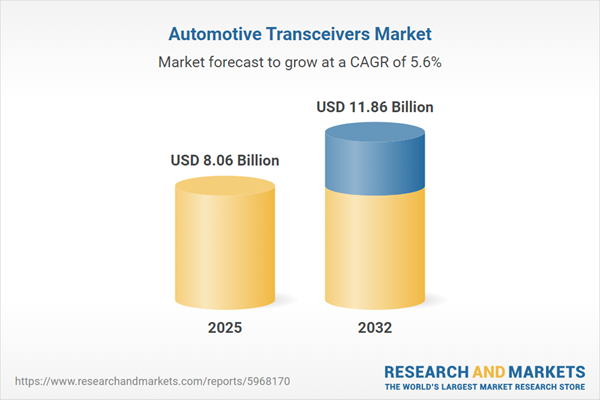Speak directly to the analyst to clarify any post sales queries you may have.
The automotive transceivers market is undergoing significant transformation, driven by accelerated connectivity demands, electrification advancements, evolving vehicle architectures, and renewed regulatory focus. Senior executives navigating this space require forward-looking intelligence to address strategic and operational priorities effectively.
Market Snapshot: Automotive Transceivers Market Size and Growth
The automotive transceivers market grew from USD 7.65 billion in 2024 to USD 8.06 billion in 2025. Continuing at a CAGR of 5.63%, projections indicate the market will reach USD 11.86 billion by 2032. This trajectory underscores sustained growth as automotive manufacturers integrate advanced connectivity and safety features into new vehicle platforms across key global regions.
Scope & Segmentation of the Automotive Transceivers Market
- Protocols: Controller Area Network, Ethernet Transceivers, FlexRay Transceivers, Local Interconnect Network
- Type of Transceiver: Wired Transceivers, Wireless Transceivers
- Interface: Parallel Interfaces, Serial Interfaces
- Vehicle Type: Commercial Vehicles, Passenger Vehicles
- Application: ADAS & Autonomous Driving, Body Electronics, Chassis & Powertrain, Infotainment & Connectivity, Safety & Security
- End-Use: Aftermarket, Original Equipment Manufacturers (OEMs)
- Regions: Americas, Europe, Middle East & Africa, Asia-Pacific
- Companies: Analog Devices, Broadcom, Continental, Denso, Elmos Semiconductor, Ethernovia, Hella, Infineon, Kvaser, Melexis, Microchip Technology, Molex, MORNSUN Guangzhou Science & Technology, National Instruments by Emerson Electric, NXP Semiconductors, ON Semiconductor, Qualcomm, Renesas Electronics, Robert Bosch, ROHM, STMicroelectronics, Texas Instruments, Toshiba, Vector Informatik, Vishay Intertechnology
Key Takeaways for Senior Decision-Makers
- Converging vehicle networks require transceiver solutions that balance protocol scalability and robust fault tolerance for emerging connected and autonomous applications.
- Software-defined vehicle architectures drive demand for transceivers supporting remote updates, stringent cybersecurity, and high-reliability communication in complex environments.
- Regional market needs vary; for instance, North America prioritizes close OEM-supplier integration and advanced validation, while EMEA focuses on protocol standardization and hardened security.
- Collaboration among automotive and semiconductor manufacturers accelerates joint product development, enabling unified interface standards and simplifying large-scale system integration.
- Corporate sustainability objectives increasingly influence transceiver design, material sourcing, and manufacturing, in response to environmental regulations and circular economy goals.
Impact of 2025 U.S. Tariffs on Supply Chains
- U.S. tariff measures have added procurement complexity, driving near-shoring and alternative sourcing strategies among module producers and OEMs seeking to control costs and maintain reliability.
- Localization in North America encourages supplier consolidation but faces challenges with semiconductor capacity and qualification lead times, shaping future inventory and risk management practices.
- Greater investment in predictive analytics and digital supply chain tools is becoming standard to proactively manage cost fluctuations and production continuity amid ongoing regulatory shifts.
Methodology & Data Sources
This research applies a rigorous methodology integrating secondary data review, patent analysis, and primary interviews with senior executives, architects, and domain experts across automotive and semiconductor sectors. Data validation involved industry standards publications, regulatory filings, expert panels, and synthesis through triangulated insights to ensure reliability and eliminate bias.
Why This Report Matters
- Gain actionable insights to optimize investment decisions, R&D roadmaps, and regulatory compliance initiatives specific to the automotive transceivers category.
- Benchmark transceiver innovation, supply chain adaptation, and key industry collaborations for robust future-proofing and competitive positioning.
- Leverage region-specific and application-focused findings to tailor go-to-market strategies for global or localized opportunities.
Conclusion
The automotive transceivers market is experiencing notable technological and regulatory shifts. Robust stakeholder collaboration, agile development, and targeted investment will be essential for maintaining leadership amidst the next era of connected mobility.
Additional Product Information:
- Purchase of this report includes 1 year online access with quarterly updates.
- This report can be updated on request. Please contact our Customer Experience team using the Ask a Question widget on our website.
Table of Contents
3. Executive Summary
4. Market Overview
7. Cumulative Impact of Artificial Intelligence 2025
Companies Mentioned
The companies profiled in this Automotive Transceivers market report include:- Analog Devices, Inc.
- Broadcom Inc.
- Continental AG
- Denso Corporation
- Elmos Semiconductor SE
- Ethernovia Inc.
- Hella GmbH & Co. KGaA
- Infineon Technologies AG
- Kvaser AB
- Melexis NV
- Microchip Technology Incorporated
- Molex LLC
- MORNSUN Guangzhou Science & Technology Co., Ltd.
- National Instruments Corporation by Emerson Electric Co.
- NXP Semiconductors N.V.
- ON Semiconductor Corporation
- Qualcomm Incorporated
- Renesas Electronics Corporation
- Robert Bosch GmbH
- ROHM Co., Ltd.
- STMicroelectronics N.V.
- Texas Instruments Incorporated
- Toshiba Corporation
- Vector Informatik GmbH
- Vishay Intertechnology, Inc.
Table Information
| Report Attribute | Details |
|---|---|
| No. of Pages | 191 |
| Published | November 2025 |
| Forecast Period | 2025 - 2032 |
| Estimated Market Value ( USD | $ 8.06 Billion |
| Forecasted Market Value ( USD | $ 11.86 Billion |
| Compound Annual Growth Rate | 5.6% |
| Regions Covered | Global |
| No. of Companies Mentioned | 26 |









